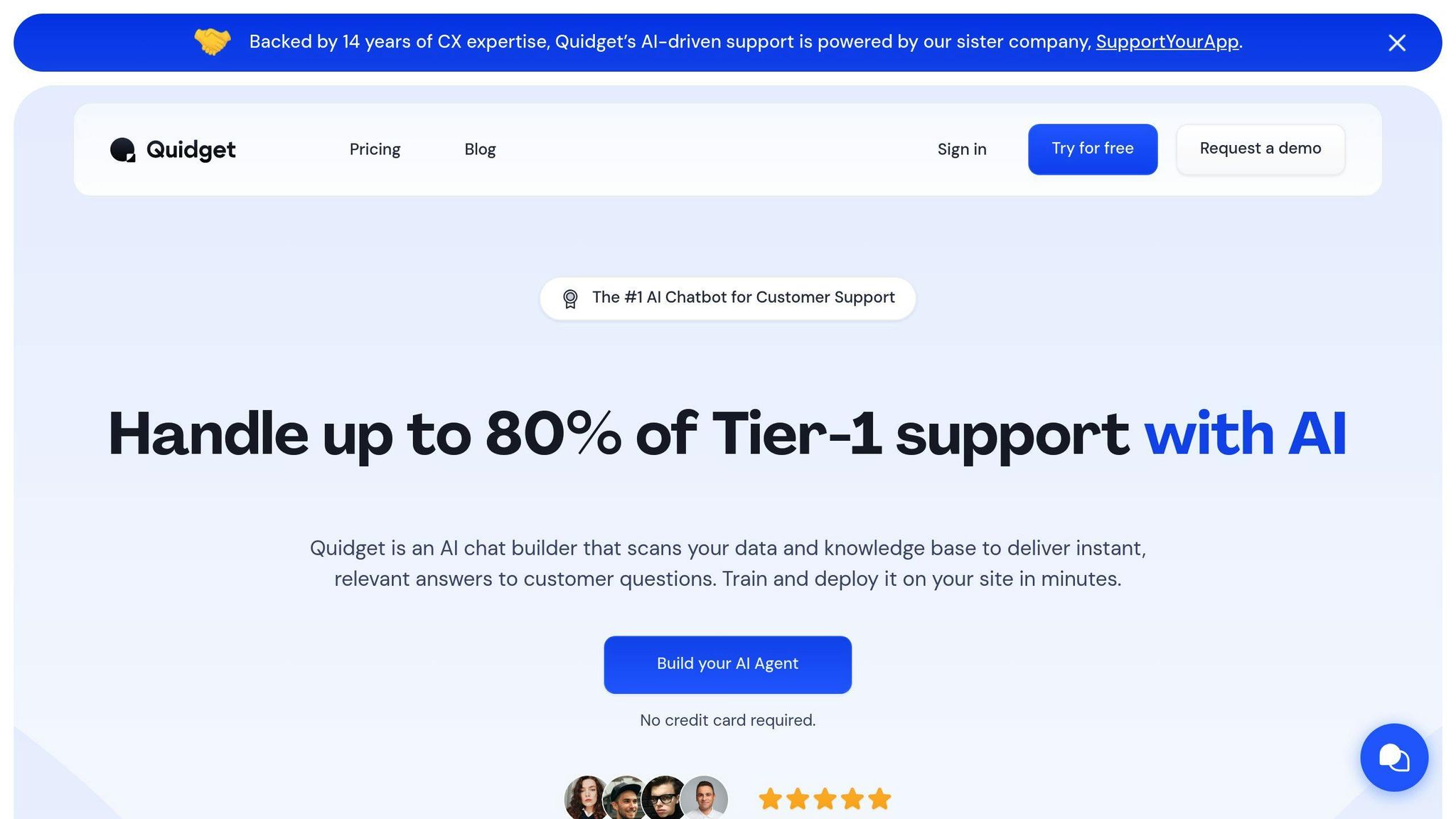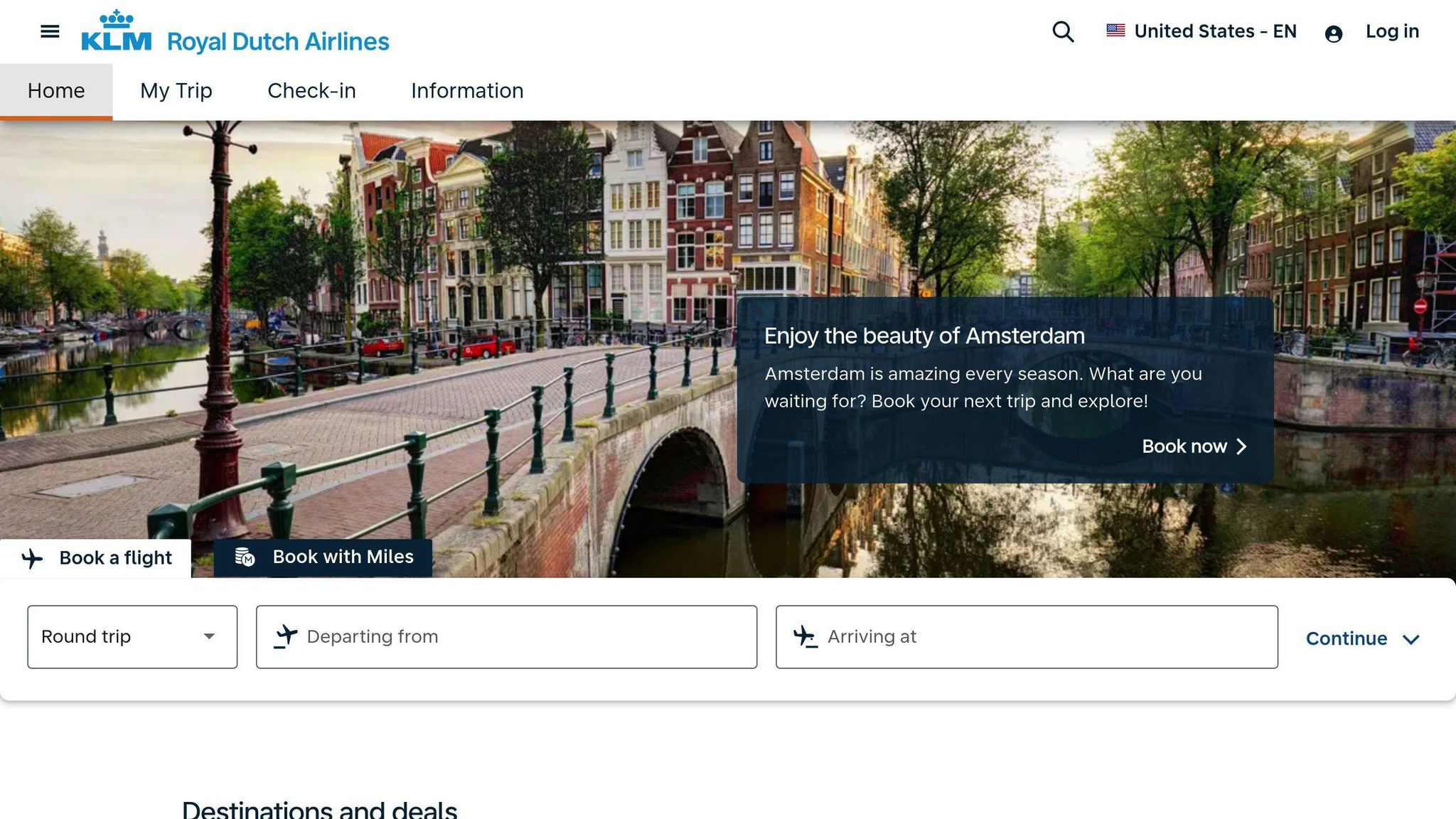AI chatbots are transforming how businesses convert website visitors into paying customers. They provide 24/7 support, handle up to 80% of routine inquiries, and boost sales by 10%-100%. By integrating with CRMs, chatbots offer personalized recommendations based on browsing history and past purchases, like Sephora’s chatbot, which increased conversion rates by 11%. They also improve lead quality, with 55% of companies reporting better leads.
Key Benefits of AI Chatbots:
- Instant Support: Reduces response times by 80%.
- Personalization: Tailored experiences based on customer data.
- Lead Generation: Tools like KLM’s chatbot increased leads by 40%.
- Cost Savings: Automates repetitive tasks, freeing up human agents.
Platforms like Quidget offer affordable, no-code solutions, starting at $79/month, with support for 80+ languages. Whether improving customer support or driving sales, AI chatbots are a powerful tool for businesses to grow.
Related video from YouTube
How AI Chatbots Boost Sales
AI chatbots have reshaped how businesses interact with online customers, acting as round-the-clock sales assistants. By using advanced technology, these chatbots turn casual visitors into paying customers through timely, personalized interactions.
Key Features of AI Chatbots and Their Impact
AI chatbots come equipped with tools that directly influence sales. By addressing customer questions instantly and offering tailored support, they help guide users from browsing to making a purchase.
Here’s a breakdown of their features and how they benefit both businesses and customers:
| Feature | Business Impact | Customer Benefit |
|---|---|---|
| 24/7 Availability | Reduces response time by up to 80% | Immediate support, no matter the time |
| Natural Language Processing | Resolves queries more effectively | Smooth, human-like conversations |
| CRM Integration | Delivers relevant recommendations based on customer history | Personalized shopping experience |
| Multi-language Support | Expands global reach | Assistance in the customer’s preferred language |
Why Personalization Matters
Tailored experiences are at the heart of successful chatbot use. By integrating with CRM systems, AI chatbots can offer highly personalized interactions that significantly boost conversion rates. They use browsing history, past purchases, and preferences to make relevant recommendations and provide meaningful support.
For example, chatbots can reference previous orders, suggest related products, recognize loyalty status, and adjust their tone of communication based on earlier exchanges. This approach works particularly well in industries like retail and services, where understanding customer behavior is key.
By analyzing patterns and past purchases, chatbots can even anticipate customer needs, offering solutions before the customer realizes they need them. This proactive approach creates a helpful and efficient sales experience.
With their ability to offer instant, tailored assistance while keeping interactions personal, AI chatbots enhance both sales performance and customer satisfaction. They provide the kind of seamless shopping experience today’s customers increasingly expect. Now, the focus shifts to strategies that can further amplify their impact on sales.
Effective Strategies for Using AI Chatbots to Increase Sales
Engaging Visitors with Behavioral Triggers
AI chatbots can engage visitors by reacting to their behavior on your site. For instance, if a user spends a lot of time on a product page or abandons their cart, the chatbot can step in with a personalized message. These timely interactions might include product suggestions or exclusive discounts, encouraging users to complete their purchase.
Besides boosting engagement, chatbots also take the load off customer service teams by handling repetitive tasks.
Improving Customer Support Efficiency
AI chatbots excel at handling common customer inquiries like FAQs, product details, order tracking, or basic troubleshooting. This automation can cut down support queues by as much as 80%, offering quicker resolutions for customers. Meanwhile, your human agents can focus on more complex issues that require a personal touch.
Once customer support runs more smoothly, chatbots can also help businesses uncover and nurture new leads.
Enhancing Lead Generation with Chatbots
Take KLM, for example – their chatbots increased lead generation by 40% and slashed response times by a factor of 50. These results highlight the potential of well-designed chatbot interactions.
Chatbots gather useful customer data during conversations, such as preferences and buying intentions. This information helps sales teams zero in on the most promising leads. By maintaining consistent engagement and providing insights, chatbots not only improve lead generation but also create meaningful interactions that can lead to sales.
sbb-itb-58cc2bf
Selecting and Setting Up the Right AI Chatbot
Picking the right AI chatbot solution is crucial if you want to boost conversions. It’s all about finding a chatbot that fits your needs and integrates smoothly into your existing systems.
Factors to Consider When Choosing a Chatbot
To make the most of your chatbot, you’ll need to evaluate a few important factors. For starters, make sure it works well with your CRM and messaging platforms. This will help maintain consistent and personalized interactions with your customers.
Another key point is scalability. Your chatbot should handle high traffic without slowing down, especially during busy periods. If your business experiences seasonal spikes, ensure the chatbot can manage those fluctuations effectively.
| Key Selection Criteria | How It Helps Conversions |
|---|---|
| Integration Options | Enables personalized and seamless interactions |
| Scalability | Keeps performance steady during peak times |
| Language Support | Reaches a global audience |
| Analytics Capabilities | Measures and improves conversion rates |
| Customization Options | Matches your brand’s tone and style |
Once you’ve chosen the right chatbot, setting it up correctly is just as important to get the most out of it.
Quidget: A Budget-Friendly Chatbot Option

Quidget is a no-code chatbot platform that supports over 80 languages, making it a great choice for businesses with international customers. It’s designed to handle up to 80% of Tier-1 support questions, which can drastically cut down response times.
For businesses on a budget, Quidget offers a free plan for basic needs. If you’re looking for more advanced features, their Pro plans start at $79/month, making it an affordable option for companies aiming to increase conversions.
After selecting a chatbot like Quidget, proper training and customization are key to making it work effectively for your business.
Training and Customizing Chatbots
Training and customization are what transform a chatbot into a valuable tool for driving conversions. Start by analyzing your customer service data to create responses that address common questions and guide users toward taking action.
When customizing your chatbot, make sure its tone matches your brand. Use clear and conversational language, and program it to provide accurate, helpful information. This approach will not only improve customer interactions but also help you achieve your business goals.
Examples of Successful AI Chatbot Use
Let’s look at how some top companies have used AI chatbots to boost customer engagement and conversion rates through practical applications.
Sephora‘s Chatbot for Personalized Shopping
Sephora’s chatbot on Facebook Messenger is a great example of how businesses can use AI to enhance the shopping experience. It offers features like virtual shade matching, customized product recommendations, and even lets users book in-store appointments. This seamless blend of online and in-store services has helped Sephora lower product return rates while increasing customer engagement and sales.
What makes this chatbot successful is its ability to simplify the shopping process. By combining personalized advice with useful tools, Sephora makes it easier for customers to find and buy the products that suit them best.
KLM‘s Chatbot for Customer Service

KLM Royal Dutch Airlines has shown how AI can handle large volumes of customer inquiries efficiently. Their chatbot handles questions from passengers, leading to a 40% jump in lead generation and cutting response times significantly – by as much as 50x. By automating routine tasks, KLM turns more inquiries into bookings while keeping service quality high.
This example highlights how well-planned chatbot use can improve both efficiency and customer satisfaction, especially when dealing with large-scale interactions.
These cases show how AI chatbots, when used effectively, can help businesses achieve better results – whether it’s increasing sales or improving customer service.
Conclusion
AI chatbots are transforming how businesses engage with customers, driving up conversions and satisfaction rates. They can increase sales by up to 67% and resolve inquiries 18% faster than older methods. By handling repetitive tasks, these tools free up support teams, saving around 60 hours each month to focus on more complex challenges and strategic goals.
Companies like Sephora and KLM showcase how chatbots can thrive in different industries, but their impact goes far beyond individual examples. With 71% of inquiries successfully resolved via AI chatbots, they’ve become a cornerstone of modern customer service strategies.
Benefits of AI Chatbots:
- 24/7 availability with quick and accurate responses
- Personalized experiences through CRM integration
- Streamlined lead qualification and nurturing processes
For businesses ready to explore AI chatbot solutions, platforms like Quidget offer an easy entry point. With features such as support for over 80 languages and smooth integration with popular tools, Quidget allows companies to adopt AI without needing major technical expertise or resources.
Whether it’s engaging visitors with tailored prompts or making customer support more efficient, AI chatbots provide a powerful way to improve service. The key lies in thoughtful setup and ongoing adjustments, always keeping measurable results and customer satisfaction as top priorities.
FAQs
Here are answers to some common questions about how AI chatbots can help boost conversions and improve customer engagement.
What is the conversion rate for chatbots?
In the SaaS industry, companies have seen up to a 70% increase in signup conversions after implementing AI chatbots. Results can differ based on the industry and how well the chatbot is set up, with e-commerce and service sectors often seeing the best outcomes.
How do AI chatbots improve lead generation?
AI chatbots streamline lead generation by engaging users automatically. They qualify potential customers through smart, conversational exchanges, collect useful data, and pass promising leads to sales teams. This setup allows businesses to scale lead generation without losing the personal touch.
What role does personalization play in conversions?
Personalization is key to boosting conversions. By offering tailored recommendations based on customer data, chatbots can drive better results. For example, Sephora’s chatbot saw an 11% increase in conversion rates by suggesting products matched to individual preferences.
What features should businesses prioritize in chatbots for conversions?
Here are some important features to look for:
| Feature | Why It Matters |
|---|---|
| Natural Language Processing | Enables smooth, human-like conversations |
| Multi-language Support | Reaches a broader audience |
| Customizable Design | Matches your brand and user needs |
| AI-driven Responses | Delivers smart, relevant interactions |
| CRM Integration | Creates personalized experiences |
| Analytics Dashboard | Tracks and improves performance |
How can businesses measure chatbot success?
To evaluate how well your chatbot is performing, focus on these metrics:
- Conversion rates
- Number of leads generated
- Customer satisfaction scores
- Improvements in response times
Leverage analytics tools to monitor these metrics and fine-tune your chatbot’s performance.



